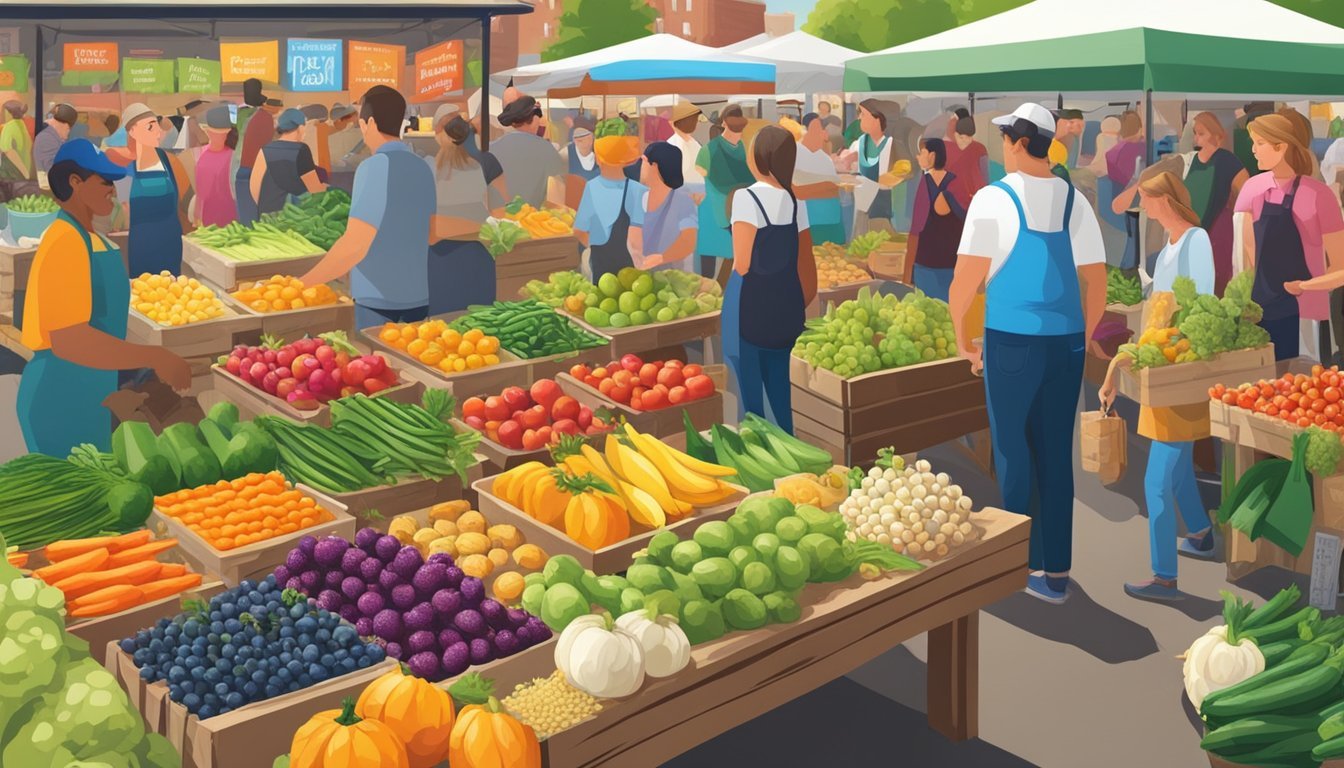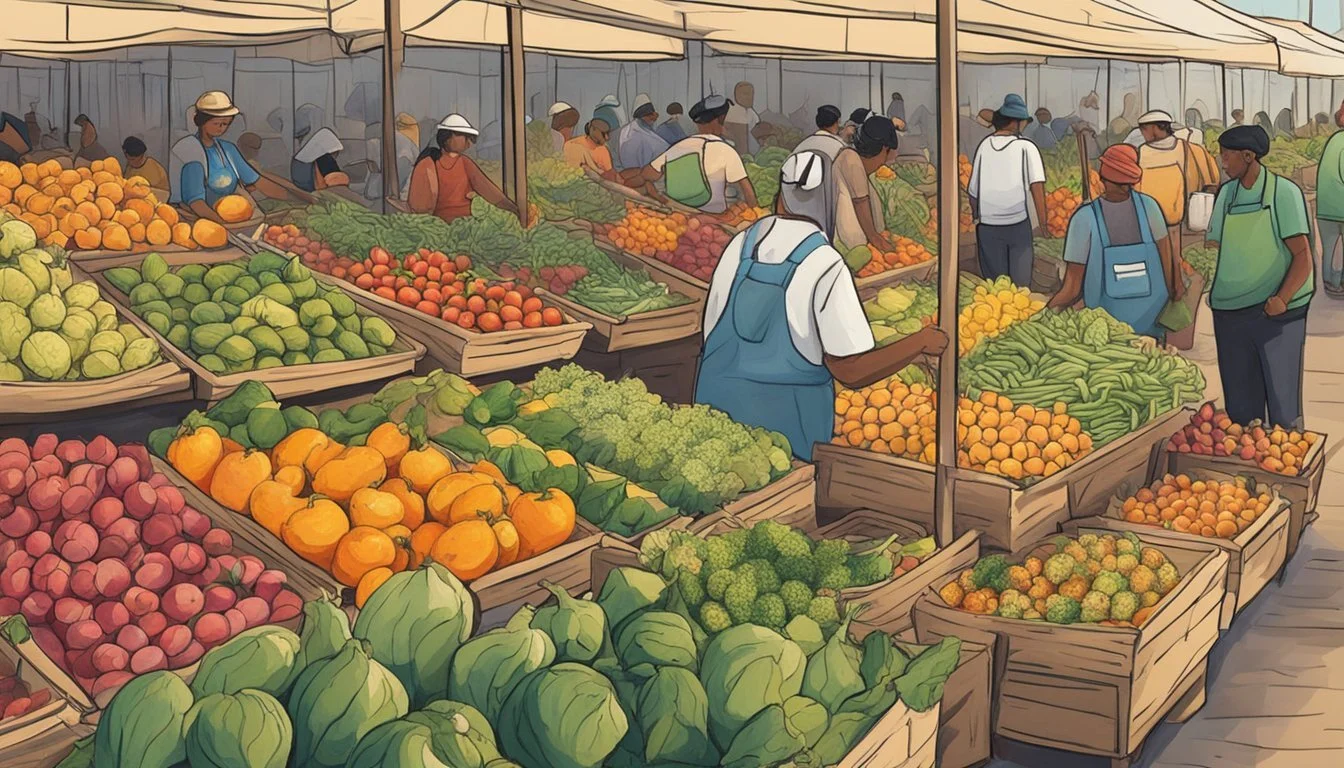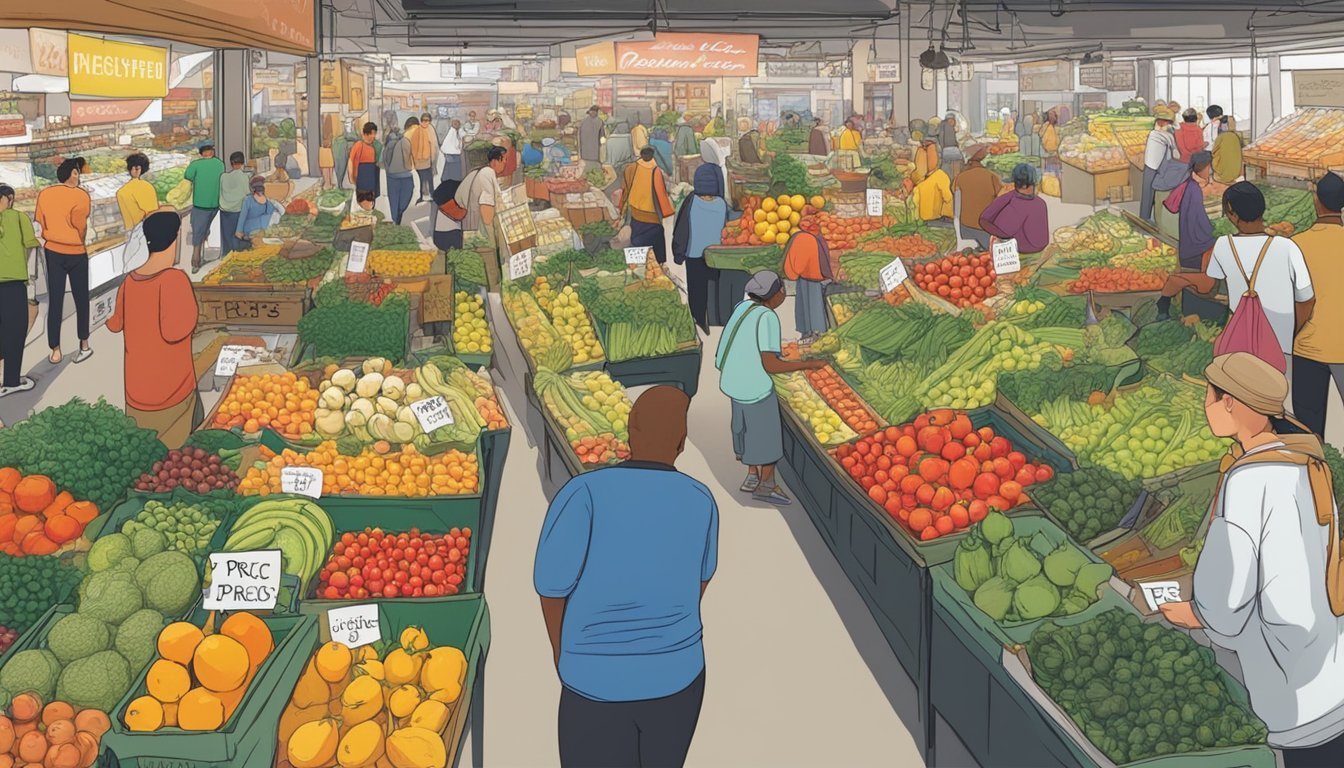The Secret Language of Farmers' Market Pricing
Decoding Cost Signals
Understanding the pricing strategies at farmers' markets is a nuanced affair that extends beyond the mere tag attached to produce. Consumers often notice that the prices at these markets can differ significantly when compared to retail outlets. At farmers' markets, prices reflect not just the cost of food production but also the value of direct-to-consumer sales, freshness, and the sustainable practices often employed by small-scale farmers. These markets act as a hub for community members who are willing to pay a premium for quality and the experience of buying directly from the source.
One key aspect of farmers' market pricing is the psychological approach known as charm pricing. This technique involves pricing items just below a round number – for example, listing a product at $2.99 instead of $3.00. The subtle difference plays on consumer perception, registering the price as notably less in the buyer's mind. Additionally, farmers must consider the complete cost of bringing their goods to market, including production, labor, transportation, and other required resources.
Farmers' markets serve a dual purpose as centers for local food distribution and as social enterprises that foster direct relationships between producers and consumers. The pricing strategies reflect this dual nature, balancing a fair return for the grower with accessible prices for the shopper. As sustainable practices and local food systems gain popularity, understanding the intricacies of pricing at farmers' markets becomes an indispensable skill for both new farmers and informed consumers.
Understanding Farmers' Market Pricing
When navigating the nuanced landscape of farmers' markets, understanding pricing becomes pivotal to ensure fair value exchange. Vendors must consider both their costs and customer psychology when setting prices for their produce and products.
Importance of Pricing Strategy
A vendor's pricing strategy is crucial as it directly impacts their ability to remain sustainable and competitive. Setting prices too low could mean not covering the costs of production, while too high could deter potential customers. A balanced pricing strategy takes into account various components such as cost-plus pricing, which adds a markup to the cost of production, and target return pricing, aimed at achieving a specific return on investment.
Psychological factors also play a role. For instance, psychological pricing, like setting an item at $2.99 rather than $3.00, can make a price seem significantly lower due to the "left digit effect". This strategy is often employed to appeal to consumers' perception of getting better value.
Components of Product Pricing
Product pricing at farmers' markets is influenced by several factors. The base price is often derived from the costs of production, including labor, materials, and overhead. From there, vendors may consider:
Cost-Plus Pricing: Calculating total costs and adding a set percentage to determine the sales price.
Subscription Pricing: Offering products at a recurring fee, which is beneficial for both consumer loyalty and steady income for the vendor.
Target Return Pricing: Setting prices with a particular profit margin in mind to achieve financial goals.
Moreover, it's not just about covering costs but also understanding the value proposition offered to customers. Unique or high-quality items often command higher prices. Additionally, seasonal variances in supply and demand can necessitate adjustments to pricing strategies to remain competitive while promoting sales.
Marketing and Customer Engagement
Successful farmers' market vendors understand that the key to increasing profitability involves not just setting the right price but also creating a strong bond with customers through effective marketing and maintaining high-quality service.
Building Customer Relationships
Customers often gravitate towards farmers' markets for the quality of produce and the personal touch they receive from vendors. Building customer relationships is critical, as repeat business is a foundational element of market success. Engaging customers personally, answering their questions, and remembering their preferences can contribute significantly to customer loyalty. A friendly conversation or a simple thank you can make a customer feel valued and more likely to return.
Marketing Approaches for Farmers Markets
The marketing approaches a vendor takes can dramatically influence their stall's success at farmers' markets. Utilizing the Internet to announce their market presence can attract a wider audience. Market managers play a pivotal role in orchestrating the collective marketing efforts, such as through social media promotion and organizing market-wide events. Quality produce, attractive branding, and clear signage all serve as silent salespeople, while sound marketing strategies, like competitive pricing and product differentiation, keep customers returning.
The Role of Service in Pricing
While pricing is predominantly influenced by production costs and market rates, the level of customer service provided can justify a premium. Vendors who invest time in receiving customers warmly and providing exceptional service foster a reputation that can command higher prices. At the same time, clear communication of value, transparency about farming practices, and consistent product quality ensure that customers feel their expenditure is justified, thus enhancing the vendors' profitability.
Agricultural Business Fundamentals
In the context of farmers' markets, grasping the economics of agricultural business is essential for farmers to turn a profit while offering competitive pricing. This includes understanding the intricacies of production costs, the fluctuations of the market, and the temporal nature of their produce.
Understanding Costs and Labor
The financial sustainability of an agricultural enterprise hinges on accurately accounting for production costs and labor. Farmers must consider a broad range of expenses, including but not limited to seeds, fertilizers, equipment, and the significant investment of time and physical labor. Organic produce typically incurs higher production costs due to more labor-intensive practices. An enterprise budget can help farmers track these costs and manage finances effectively.
The Dynamics of Supply and Demand
Supply and demand dynamics are critical in setting prices for crops and agriculture products at farmers' markets. When there is an abundance of a particular crop, prices may decrease to encourage sales. Conversely, limited supply of a popular or locally grown item could justify a higher price point, bolstering its perceived value.
Seasonality and Its Impact
Seasonality plays a fundamental role in the availability and pricing of farmers' market produce. Fresher, locally grown products typically have a peak season during which they are in high demand. Understanding these seasonal trends allows farmers to plan for fluctuations in income and to set prices that reflect the uniqueness and optimal taste of seasonal produce.
Evaluating Profit Margins and Income
Lastly, evaluating profit margins and income is vital for the long-term viability of an agricultural business. By analyzing the difference between the costs of production and the revenue from sales, farmers can determine if they are on track to be profitable. This assessment helps in making informed decisions about pricing strategies that align with their brand identity and consumer expectations of quality and value.
Local Community and Economy
Farmers' markets play a critical role in sustaining the local economy and fostering a sense of community. They act as catalysts for local agricultural businesses and create an environment where collaboration and competition thrive amongst local vendors.
Supporting Local Agriculture
When consumers purchase directly from farmers' markets, they bolster the viability of local agriculture. The presence of markets offers farmers the opportunity to sell their goods, which often include organic produce, fresh meats, and other farm-to-table products. This direct sales channel can result in fairer prices for consumers, as well as greater income for producers since the middleman is eliminated.
Competition and Collaboration with Local Vendors
Farmers' markets introduce a unique dynamic of competition and collaboration among local vendors. While they compete for consumer attention, often vendors specialize in particular products—whether it be heirloom tomatoes, free-range chicken, or handmade cheeses—creating a diverse marketplace. This diversity can lead to collaboration, as vendors may share best practices in organic farming or marketing strategies, ultimately benefiting the health of the local economy.
Quality, Selection, and Certification
Farmers' market pricing not only reflects the growing practices and quality of produce but also the value added through variety, certification, and organic standards. Shoppers often look for indicators like organic certification to guide their purchasing decisions, associating such labels with high quality.
The Value of Organic and Certified Produce
The premium pricing of organic produce at farmers' markets is often justified by the rigorous standards these products meet to ensure safety, environmental impact, and absence of synthetic pesticides and fertilizers. Organic certification acts as a seal of approval, confirming that a farmer adheres to national organic standards. Customers are generally willing to pay higher prices for certified organic items due to the perceived health and environmental benefits.
Certified organic produce is subjected to:
Stringent regulations
Periodic inspections
Comprehensive documentation
These processes ensure the integrity of the organic claim and justify the often higher price point compared to conventionally grown products.
Product Variety and Selection
Farmers' markets are known for offering a wide selection of produce, some of which are unique or heirloom varieties rarely found in traditional retail settings. This extensive variety caters to niche tastes and preferences, enabling vendors to price items based on rarity and demand.
Factors influencing selection and pricing include:
Seasonality
Locality
Uniqueness
Farmers who offer a diverse selection of high-quality products can attract specific segments of the market looking for distinct flavors or items that support biodiversity, further impacting pricing.
Pricing Tactics and Adjustments
In the dynamic environment of farmers' markets, pricing tactics serve as a strategic tool for vendors. They are used to respond to competition, cover costs, and meet revenue targets while also factoring in customer psychology.
Choosing the Right Pricing Methods
Cost-Plus Pricing: This method involves adding a markup to the cost of producing goods. For example, if a tomato costs $0.79 to produce and is sold for $2 per pound, the profit margin is $1.21 per pound.
Competition-Based Pricing: Vendors often set prices in relation to their competitors’ pricing. Vendors must be informed about their competitors' prices and adjust their pricing strategies to retain a competitive edge.
Value-Based Pricing: Vendors can determine prices based on the unique attributes of their produce, such as organic certification or freshness. This attaches a premium to goods that are perceived as higher value by customers.
Psychological Pricing: Incorporating pricing strategies that resonate psychologically with consumers can be effective. For instance, setting a price at $2.99 instead of $3.00 can influence perception due to the "left digit effect."
Adapting Prices for Market Changes
Subscription Pricing: In response to market changes, such as seasonal shifts, farmers may adopt subscription pricing to stabilize revenue. This involves customers paying a recurring fee for regularly supplied produce.
Target Return Pricing: Farmers might employ target return pricing to meet specific income goals. Adjustments are made based on fluctuating costs and sales to hit the desired return.
Dynamic Pricing: Adjustments are crucial when responding to immediate market changes, like weather impacts on crop yield. Dynamic pricing allows vendors to modify prices based on current demands and supply levels.
Outreach and Education
Farmers' market pricing not only has an economic impact but also serves as an educational tool, helping to inform and teach both vendors and consumers about the value of locally sourced produce. The Penn State Extension provides resources aimed at enhancing this understanding, while various workshops and webinars address the intricacies of market pricing strategies.
Penn State Extension and Educational Resources
Penn State Extension offers a wealth of educational materials tailored to assist farmers' market vendors in pricing their products appropriately. These resources include:
Budgeting Tools: Detailed templates for calculating the true cost of production, from seed acquisition to market sales.
Pricing Guides: Publications that provide market price benchmarks and strategies for competitively pricing goods while ensuring profitability.
Workshops and Webinars on Market Pricing
A series of workshops and webinars contribute significantly to vendor education:
Workshops: Interactive sessions conducted at various locations, offering vendors hands-on experience and guidance on pricing products effectively.
Webinars: Online educational seminars that vendors can attend remotely, covering topics such as:
Pricing Strategies: Methods for setting prices based on market trends and production costs.
Consumer Education: Approaches for communicating the value of farmers' market products to customers, potentially justifying higher prices compared to retail.
Environmental and Social Responsibility
Farmers' markets promote environmental stewardship and foster social cohesion by incentivizing sustainable farming and facilitating programs that serve the community.
Sustainable Agricultural Practices
Sustainable practices among vendors at farmers' markets often include organic methods that limit synthetic pesticides and fertilizers, promoting healthier soil and ecosystems. Markets that prioritize organic produce provide a direct-to-consumer platform for locally grown goods, reducing food miles and carbon footprints. The selection of produce at these markets often reflects seasonal availability, encouraging crop rotation and biodiversity.
Organic Produce: Products free from synthetic additives.
Gardens: Biodiverse spaces benefiting local ecosystems.
Selection: Seasonally rotated to sustain soil health.
Community Involvement and Social Programs
Farmers' markets often serve as hubs for community programs, supporting affordability and accessibility of fresh food. Many participate in the Supplemental Nutrition Assistance Program (SNAP), allowing lower-income individuals to purchase locally grown items they might otherwise not afford. By providing such options, markets take on a social role, ensuring consumers of varying economic backgrounds have access to healthy food choices.
SNAP: Provides assistance for food purchases at markets.
Affordability: Cost-effective choices, including incentive programs.
Locally Grown: Encourages a more resilient local food economy.
Extended Market Reach
Farmers' markets are leveraging new strategies to expand their consumer base and increase revenue. Embracing digital platforms and broadening market horizons are contemporary approaches that allow producers to mitigate high production costs and elevate their market presence.
Expanding Beyond the Local Market
Farmers' markets traditionally serve the local community, but many are now reaching customers beyond their immediate locale. This strategy not only diversifies their customer base but also helps absorb agriculture production costs. Regional partnerships and participation in larger markets are two vital avenues:
Regional Partnerships: By connecting with neighboring markets, farmers can access a larger customer pool.
Larger Markets: Attending city-wide or state-wide markets can offer vendors increased visibility and higher sales opportunities.
Utilizing Internet and Social Media
The internet and social media have revolutionized the way farmers' markets connect with consumers. Online marketing efforts and social media engagement are crucial:
Online Marketing: Farmers' markets establish an online presence via websites and e-commerce, allowing customers to purchase goods directly online.
Social Media Engagement: Social media platforms enable markets to engage with a broader audience, advertise effectively, and create a loyal customer community through regular updates on offerings, events, and promotions.
Case Studies and Success Stories
In exploring the dynamics of farmers' market pricing, specific case studies reveal how successful markets and innovative strategies create value for both producers and consumers.
Local Farmers Market Successes
Local farmers markets across various regions have carved out success stories that resonate within communities. Northern Michigan, for example, boasts a vibrant local farmers market where the market manager and vendors have collaborated to fine-tune pricing that appeals to local consumers while sustaining the farmers’ livelihood. By aligning the pricing strategy with the community's expectations and purchasing power, these markets have established a loyal customer base that regularly supports the local economy.
Success Factors:
Community engagement
Competitive pricing
Market manager's active role
Innovative Pricing and Marketing Strategies
Innovative pricing and marketing strategies at farmers markets play a pivotal role in the success of these local ventures. The introduction of tiered pricing strategies for organic and conventional produce has allowed customers to make choices based on their budget and preferences. Marketing strategies that highlight the freshness and local origin of the products have also been effective. By utilizing clear signage and educating consumers on the benefits of supporting local produce, these markets turn competitors into collaborators, promoting a thriving, interconnected community of growers and buyers.
Marketing Approach:
Clear signage showcasing the local origin
Education on the benefits of supporting local farmers
Collaboration over competition among vendors
Closing Remarks
When considering the pricing of goods at a farmers' market, customers can expect factors beyond just the produce itself to influence price. These markets provide service and experience in addition to quality products. Vendors are not simply selling food; they are offering a connection to the source of one's meal, a transparent transaction directly from the earth to the table.
At a farmers' market, profit margins may differ from conventional retail due to various factors including scale of production, seasonality, and sustainable practices. While customers might notice higher prices than in supermarkets, they should recognize that these prices often reflect the true cost of small-scale, usually more sustainable agricultural production.
For market vendors, pricing strategy is a balance between covering costs, remaining competitive, and providing value to the consumer. Vendors should communicate the quality and origins of their products to justify their pricing. At the same time, understanding and respecting the customer's need for value is crucial for customer retention and market success.
In short, the secret language of farmers' market pricing isn’t so much a code to decipher as it is a conversation between vendor and customer about the value of local, often more sustainably produced goods, and the service of community engagement that these markets inherently provide.










